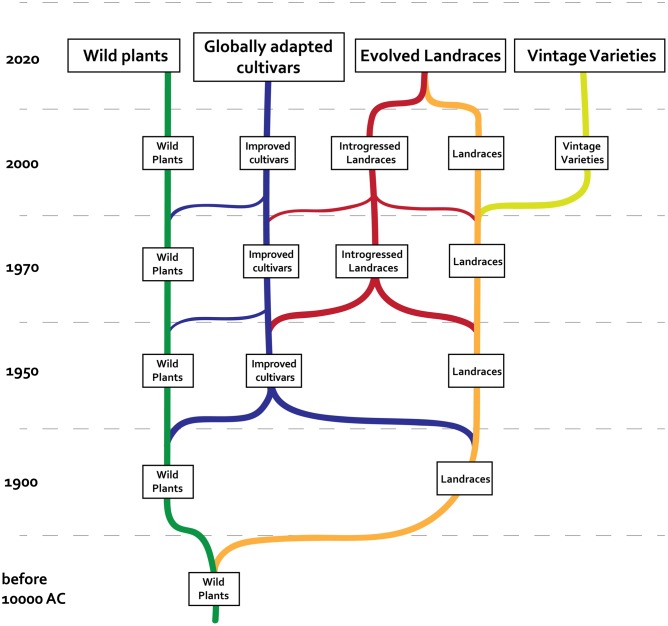What are they, and why do they matter?
The Svalbard Global Seed Vault is a testament to human science and ingenuity. It represents the largest collection of genetic diversity in the world and is intended to be the long-term seed storage facility “built to stand the test of time.”
But what is the Svalbard Vault actually protecting? And what does it have to do with cannabis cultivars?
Until the discovery of DNA as the molecular unit of chromosomal inheritance by Watson and Crick, we as a species did not really have a concept of what makes plants of the same species grow one way sometimes, and a different way another. [1] The practice of agriculture in the past 10,000 years of human development, however, had taught us that wild plants can be selectively bred to change their outer (phenotypic) appearance.
One would think that, as more people began to grow food, the amount of genetic variability in a given species of plant would grow. However, science has shown that the opposite is true; that agriculture leads to “clustering and shifting… toward crop diversity loss.” [2]
But wait—what’s the big deal with crop diversity? Is it an ‘old, old wooden ship’? Once we figure out the “best” possible plant, shouldn’t we just grow a lot of it more?
Genetic diversity is what protects the species as a whole from extinction events. Think about humans as an example. If we all had the same genes, and one person got the plague and died, then everyone around them would also get the plague and die. The same is true for plants, perhaps even more so since they are sedentary and at the mercy of Mother Nature.
Going back to our first thought, the concept of landrace varieties has been common parlance in the botanical community for well over a century and is generally understood to mean a genetic variety of a plant that is: 1) cultivated, 2) contains genetic variability, 3) differentiated and specific to a geographic area, which led to distinct adaptations to that terrain and climate. [3] They are formed when a wild-type flora is domesticated and cultivated in a discrete locale using particular cultivation practices.
Landraces are sometimes thought of as unchangeable. Sort of like the primary colors of the breeder’s crayon box. But in fact, landraces are constantly responding to evolutionary and selective pressures resulting from changing land management styles and pressure towards homogenization of the gene pool. [4] Highlighted below is a temporal graph showing the evolution of the recognized genetic classes of cultivars, and their relationships to one another:
Figure 1. Timeline of historical relationship among different kinds of plant materials and prospects for the immediate future (Casañas et al. 2017).
Because landrace varieties are under constant change, significant efforts have been made to collect and preserve so-called ‘primary’ landrace cultivars in seed banks like Svalbard. We do this so humanity has a ‘Genetic Backup Drive.’ If the genetics of the evolved landraces become so homogenized that a single disease or climate change kills the entire crop, the gene code of the primordial landrace can be recalled, from which hardier, more appropriate evolved landraces can be procured. [3]
So how does this all tie in to cannabis? Cannabis landrace varieties are the discrete regional cultivars attributed to particular geographic locations around the world (think any variety with the name of a country or land mass in it). Landrace seeds are the building blocks from which hybrids are cross-bred. In the age of molecular cloning and gene editing technology, landraces also represent the genetic back-up drive.
For example, since the 1970’s, cultivators have been selectively up regulating THC and down regulating CBD expression in their cultivars. [5] But with the discovery of the entourage effect, suddenly a return to a more even distribution of cannabinoid profiles are found to be desirable. [6] Landrace seed banks can therefore ‘restore’ the first draft, and edits can begin anew from there.
References
- Mandal, History of Genetics. Available at http://www.news-medical.net/health/History-of-Genetics.aspx. A historical review of discoveries leading to the late-20st century model of molecular inheritance mediated by deoxyribonucleic acid (DNA).
- Aguilar J, et al. “Crop Species Diversity Changes in the United States: 1978–2012”. PLoS ONE. 2015;10(8):e0136580.
- Casañas, F, et al. “Toward an Evolved Concept of Landrace”. Front Plant Sci. 2017;8:145.
- Khoury, C, et al. “Increasing homogeneity in global food supplies and the implications for food security”. PNAS.2014;111(11):4001-4006.
- Stith, S.S., and Vigil, J.M. “Federal barriers to Cannabis research”. Science. 2016;352(6290):1182.
- Ben-Shabat, S, et al. “An entourage effect: inactive endogenous fatty acid glycerol esters enhance 2-arachidonoyl-glycerol cannabinoid activity”. Eur J Pharmacol. 1998;353:23–31.










